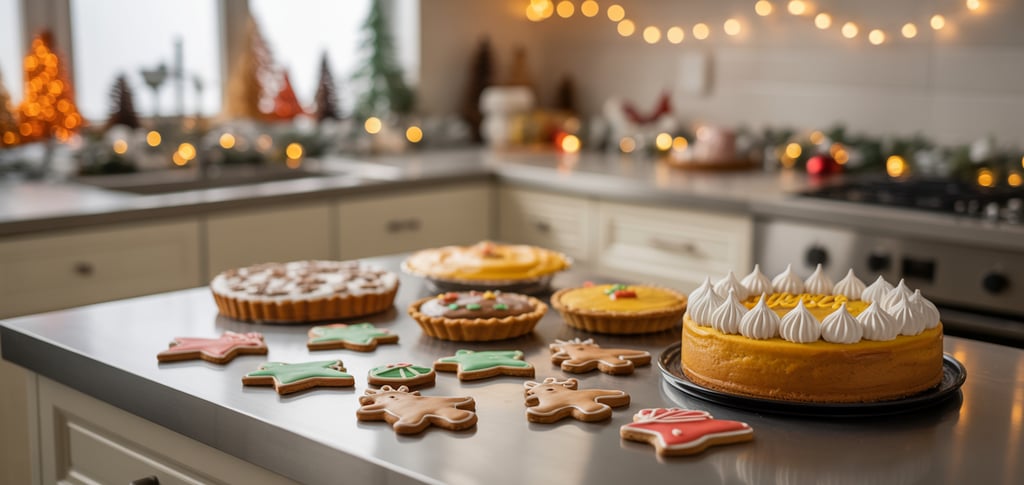From Halloween to New Year: Holiday Baking Tips
The holiday season is a time for joy, celebration, and, of course, baking! From Halloween parties to Thanksgiving feasts, Christmas cookies, and New Year’s desserts, our kitchens come alive with the aroma of seasonal treats. But while holiday baking is fun, it’s important to keep food safety top of mind. Handling ingredients properly, keeping your kitchen clean, and storing baked goods correctly ensures that your celebrations stay happy and healthy. This season is also when many bakers create lots of cookies and treats with almonds, walnuts, or even peanuts, so extra care is needed when cooking and handling ingredients. In this comprehensive guide, we’ll cover essential tips to make your holiday baking safe, enjoyable, and stress-free - from Halloween to New Year.
9/7/20254 min read


1. Clean and Sanitize Your Workspace
A clean kitchen is the foundation of safe baking. Cross-contamination can easily occur when raw eggs, dairy products, or nuts come into contact with ready-to-eat foods. Even a small oversight can lead to foodborne illnesses.
Why Cleanliness Matters
Prevent cross-contamination: Bacteria from raw ingredients can transfer to baked goods if surfaces or utensils aren’t sanitized.
Avoid allergens: Dust or residues from previous recipes can trigger allergic reactions.
Create a safe environment: A clean kitchen keeps kids and pets safe from accidental contact with sharp or hot tools.
How to Sanitize Effectively
Wipe down countertops, cutting boards, and baking trays with a mild disinfectant before and after baking.
Wash mixing bowls, utensils, and measuring cups thoroughly.
Sanitize sinks and sponges regularly, as they can harbour bacteria.
Handwashing Tips
Wash hands with soap and warm water for at least 20 seconds before starting and during baking.
Especially important after handling raw eggs, flour, or nuts.
Dry hands with a clean towel or disposable paper towel to prevent re-contamination.
2. Handle Ingredients Safely
Many holiday recipes rely on perishable ingredients that can spoil or carry bacteria if mishandled. Understanding safe handling practices can prevent foodborne illness.
Eggs, Dairy, and Perishable Ingredients
Always store eggs and dairy products in the refrigerator until needed.
Use pasteurized eggs for recipes like mousse, custard, or cookie dough that isn’t fully baked.
Avoid tasting raw dough containing eggs.
Checking Ingredients
Always check expiration dates on flour, nuts, dairy, and other packaged ingredients.
Inspect ingredients for signs of spoilage, such as off smells or discoloration.
Flour and Dry Goods
Keep flour, sugar, and spices in airtight containers to prevent contamination.
Avoid cross-contact with allergens if baking for guests with food sensitivities.
3. Involving Kids Safely
Baking with children can be one of the most memorable parts of the holidays. But safety must come first.
Assign Age-Appropriate Tasks
Toddlers: Decorating cookies, adding sprinkles, or pouring pre-measured ingredients.
Older children: Mixing dough, rolling cookies, or helping with measuring ingredients under supervision.
Avoid Burns and Cuts
Keep children away from hot ovens and stovetops.
Use child-safe utensils where possible.
Show kids how to use cookie cutters and mixers safely.
Teach Good Hygiene
Wash hands before and after baking.
Keep hair tied back and avoid touching the face.
Teach children about cross-contamination risks.
4. Bake at the Right Temperature
Correct baking ensures that treats are safe to eat and delicious.
Fully Cooked Treats
Follow recipes carefully, especially for cookies, cakes, and pastries.
Ensure custard-filled desserts or bread with fillings reach safe internal temperatures.
Undercooked dough, especially with eggs or dairy, can carry Salmonella.
Use a Thermometer
For recipes like cheesecakes or custards, an instant-read thermometer ensures safe temperatures.
Breads and yeast-based recipes should also reach appropriate temperatures to kill harmful bacteria.
Common Mistakes to Avoid
Opening the oven too frequently can lower baking temperatures.
Crowding the oven can prevent even cooking.
Ignoring the recipe’s baking time can lead to underbaked treats.
5. Watch for Allergens
The holiday season is full of baked goods that may contain common allergens such as nuts, dairy, gluten, or eggs. This is also the time when many people bake a lot of cookies and treats with almonds, walnuts, or even peanuts, so it’s especially important to be careful while cooking and handling ingredients.
Clearly mark cookies, cakes, and other items that contain allergens.
Keep allergen-free treats separate.
Substitutions
Use almond or soy milk as a substitute for dairy.
Use gluten-free flour blends if needed.
Avoid cross-contact by using separate utensils and mixing bowls.
Prevent Cross-Contact
Clean surfaces thoroughly between batches.
Wash hands and change gloves when switching between allergen-containing and allergen-free recipes.
6. Store and Transport Baked Goods Safely
Baked goods can spoil or become unsafe if not stored or transported properly.
Proper Cooling
Allow baked items to cool completely before storing.
Hot treats in containers can create condensation, leading to mold growth.
Airtight Containers and Refrigeration
Use airtight containers for cookies, cakes, and pastries.
Perishable items, like cream-filled pastries, should always be refrigerated.
Transporting Safely
Use sturdy containers to prevent damage.
Avoid stacking items too high to prevent crushing delicate desserts.
7. Handle Leftovers Properly
Leftovers are common during the holidays, and knowing how to store them safely prevents spoilage.
Room Temperature
Most baked goods (without perishable fillings) can sit at room temperature for 2–3 days.
Store in a cool, dry place away from direct sunlight.
Freezing for Later Enjoyment
Cookies, muffins, and certain cakes can be frozen for longer storage.
Use airtight freezer bags or containers and label with the date.
Check for Spoilage
Inspect leftovers before consumption.
Look for mold, off smells, or unusual textures.
8. Bonus Tips for Holiday Baking Success
Plan: Prepare ingredients in advance to avoid last-minute rush.
Read Recipes Carefully: Make sure you understand all steps before starting.
Decorating Safely: Use food-safe decorations, especially when kids are involved.
Keep Pets Away: Pets can contaminate ingredients or knock over baked goods.
Have Fun! Safety is important, but holiday baking should be joyful.
From Halloween to New Year, the holidays are filled with opportunities to create delicious treats and unforgettable memories. By following these safety tips - cleaning and sanitizing your workspace, handling ingredients properly, supervising kids, baking at the right temperatures, managing allergens, and storing leftovers safely - you ensure that your holiday celebrations are not only fun but safe.
Remember, food safety doesn’t have to be complicated. With preparation and care, you can enjoy every cookie, cake, and pastry knowing your treats are safe for everyone to enjoy.
Happy holiday baking!
Stay tuned! In our next posts, we’ll dive deeper into some of these points, including allergen-friendly baking, creative safe decorating tips, and storing and freezing holiday treats so you can get even more out of your seasonal baking.
Join us on Pinterest
letstalk@lorybs.com
© 2025. All rights reserved.
